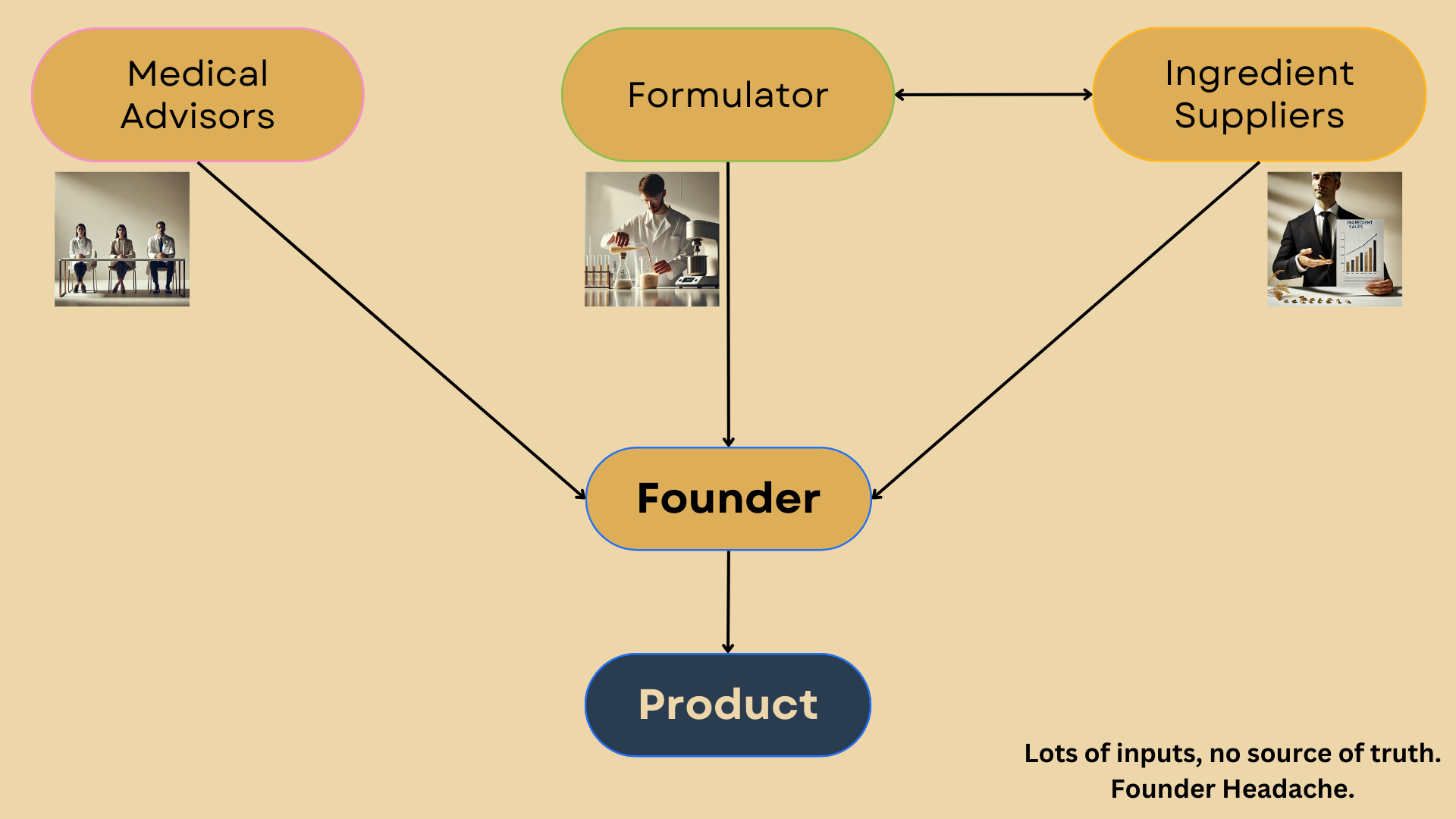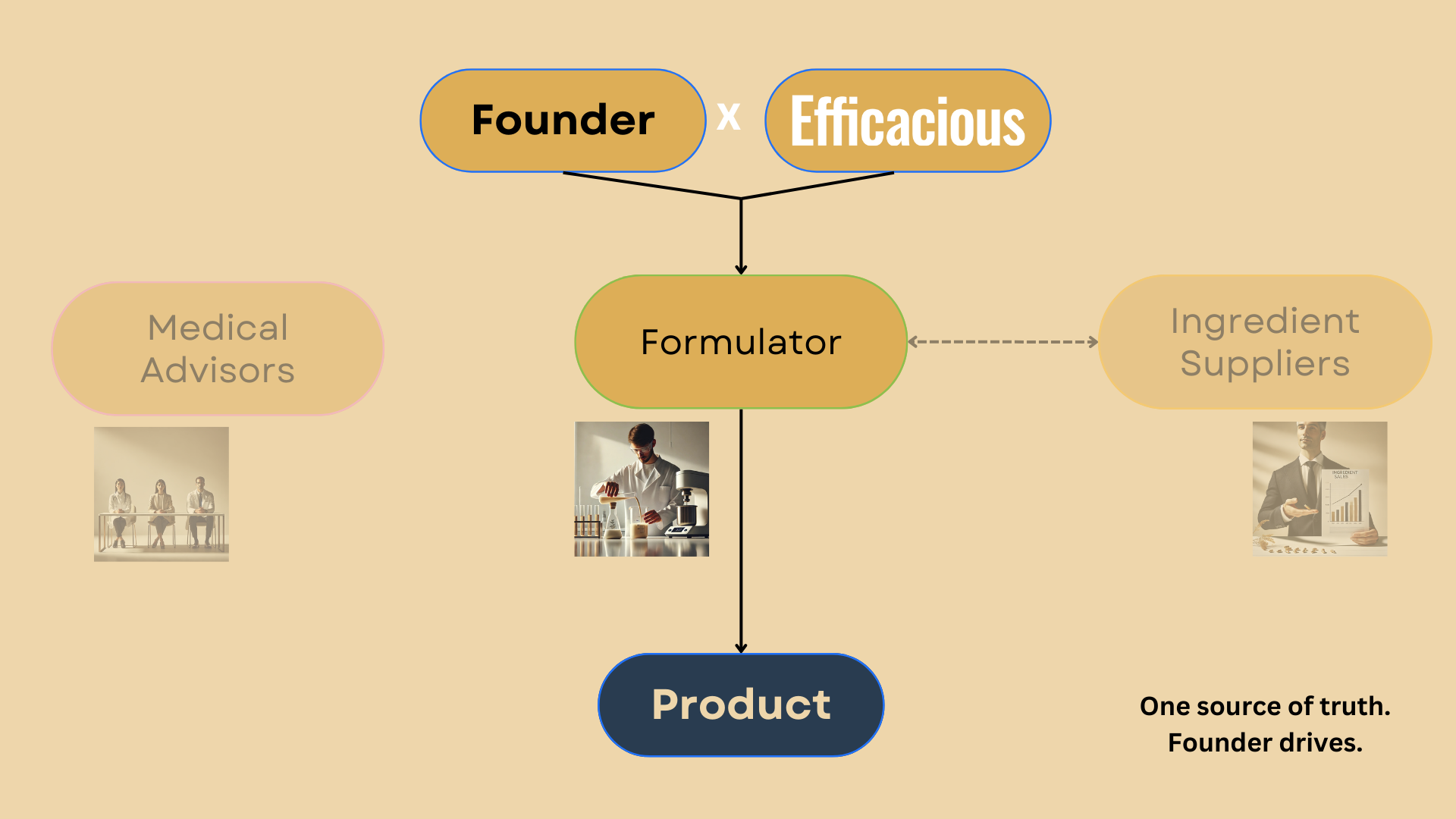Formulating your supplement product: is there an easier way?
Have some backbone.
A phrase I grew up hearing from my British grandparents. Having backbone is having courage. It’s standing up for what you believe in and not taking shortcuts.
Today it’s easier than ever to start Consumer Packaged Goods (CPG) brands in health and wellness. There are whole companies dedicated to providing you with an off the shelf formula that you can slap a label on and start marketing to tweens on Tiktok. While there’s nothing inherently wrong with this, I wish more founders were able to have a bigger impact on their customers by building more intentional, more powerful formulas. By definition, using whitelabel formulas means your product is not differentiated, it will trend towards average - it’s “slop”.
A health brand built with backbone is built to go the distance. We should strive to build brands that are trusted for decades to come.
Designing great functional health and wellness products requires understanding the science, understanding what people want, and knowing how to sell it to them. If you want the likes of Joe Rogan and Andrew Huberman to one day talk about your product on their shows, you’ve got to nail at a minimum the science, but realistically the other two as well.
I studied Biology at Oxford. In the UK, you do just the subject that you applied for. So it was a lot of bio. Statistics, reading literature, learning to critique academic papers and not take them at face value. I love the process of science. You can look at what others have done before you, see the strengths and weaknesses of their studies and build your own on top of those that came before. It’s also a goldmine of information for designing functional products.
From an academic journal article you can learn so much, including:
the effects of different doses or amounts of an ingredient
Effects on specific populations (i.e. age groups, genders, non-smokers vs smokers)
Side effects
Magnitude of the effects (meh, or holy shit this ingredient is a gamechanger!)
When I started Hydrant in 2017, I read through hundreds of academic journal articles to design my formula. I made a database outlining the findings of every paper, and ranked those papers for how reliable their methods were.
I wasn’t just looking at studies on the best formula to rehydrate you. I wanted to understand the whole landscape and be able to talk about it in our marketing. So I was looking at papers on the effects of dehydration, the causes of dehydration, the chronic conditions that involve dehydration. Hundreds of papers.
That foundational database became known as the “Research Vault”.
Using the Research Vault, I was able to design a functional formula that hydrated people better than the main players in the market like Gatorade, coconut water etc. The landscape since then has changed drastically and there are many other competitors with similar formulas.
The other thing I did with the Research Vault was build a more readable document that described each of the ingredients we used in plain english. What it is, what it does, how it works, why we included it in our product, clear descriptions of how studies support its efficacy, any side effects noted, and suggested language to talk about it with customers. This document came to be known as the “Brand Backbone”.
As the only scientist in the business, I was a bottleneck for any science questions from our team, marketing partners, investors and customers. When you make something that people ingest or put on their skin, you need to build trust with them that you made decisions with their best interest in mind when you designed your product.
By creating the Brand Backbone, everyone on my team could become an advocate not only of the brand but of the science that underpins the product. The Backbone.
Years later, having stepped back from the day to day at Hydrant, I’ve realized that there are many founders who want to build or are building in the health and wellness space who do not have the science background to build their own brand back bone or a great formula. I wanted to help them, so I started Efficacious, where we build your Research Vault and Brand Backbone for you.
How we fit:
It takes a village to get a product to market, and there are different players involved. Here’s a quick primer:
Formulator:
Food scientist for ingestible products (food, drink, supplements)
Chemist for skincare/beauty products.
These folks know a lot about the different processes used in making a finished product, what pH your liquid needs to be before it gets bottled, what % overage of an ingredient you need because vitamins degrade overtime and what % of magnesium citrate is actually magnesium. They also know how to make things taste good / feel good / smell good. That is incredibly valuable!
What is a Formulator not?
They are not trained to study the effects of an ingredient on humans.
They are not doctors, nutritionists or biologists.
Nutritionist / Doctor / Science Advisor
Often early stage entrepreneurs who see an opportunity in the market want to get some instant credibility by recruiting health professionals as advisors to help advise on the formula.
The reality is these relationships are really hard to broker. Doctors and nutritionists might know a good deal about the needs of their patients, but when it comes to designing a product for those patients with the ability to scale beyond, they won’t necessarily be reading all the latest research. Often doctors are behind trends in research because they have to be so cautious due to legal liability.
These people are rarely as helpful at formulation, claims building and marketing language as you would like.
Ingredient Supplier
Companies that sell ingredients are an important piece of the puzzle here. Some of them sell commodity ingredients, but the sales people are often food scientists and can advise you how best to use their ingredients.
Some companies trademark their ingredients and run scientific studies on them. If you buy their trademarked ingredient (yes, it’s more expensive than the regular version) you can use the claims that their studies produced. This is where I would caution that the quality of many of these studies is questionable. You should be getting detailed information on how many people were in the study, how big the effect was etc. Often the companies are not forthcoming with this info, because the studies are a little dubious. The interpretation of scientific data in this industry is barely regulated, if at all, so the bad actors in the system can present claims that may fall short for your customers when it’s in the final product.
Status Quo for designing your own formula:
This is how the process of custom designing your formula can look today - it’s no wonder people go the path of least resistance and white label things. You get a fancy medical advisor who has opinions, your formulator will have input, and you’ll be talking to ingredient suppliers who will be pushing their own agenda on your product direction.
Your job in this old model is to try and put together a product that fits your vision whilst also taking input from these three groups, and hopefully your customers as well!
This process can be overwhelming, as there’s no source of truth. Each party here has their own agenda that is slightly different to yours, and it would be so much easier with you fully in the driver's seat and these folks along for the ride. Or even for those additional stakeholders to be optional. That’s how we do it:
Efficacious works by first gathering what information you have:
Current formula if it’s already in market
Target demographic
Desired claims
Any constraints or philosophies on specific ingredients (e.g. no melatonin under any circumstances).
We go away and sift through the academic research available to help you formulate your product, and then tell stories about it better. For example:
Here’s why we included sugar in Hydrant, it’s functional!
Here’s why we didn’t include melatonin in our sleep formula:
Etc.
When designing your products, you’ve got to be thinking about what stories you will tell about it. What will your customer tell their friend when they are recommending it. That’s your job as the founder, none of the other stakeholders are thinking about that. We empower you to figure out what those differentiated stories are with evidence from research.
Building trust with your end customer is the highest value activity you can be doing other than getting their feedback. Being able to have every marketing message they receive from you be consistent across social media, customer service interactions, press, packaging and beyond is a powerful marketing tool.
So if you’re working on launching a new product, or just want to tighten up your science and storytelling, please do get in touch. We believe that all brands in health and wellness should have a backbone. We help you find yours.




